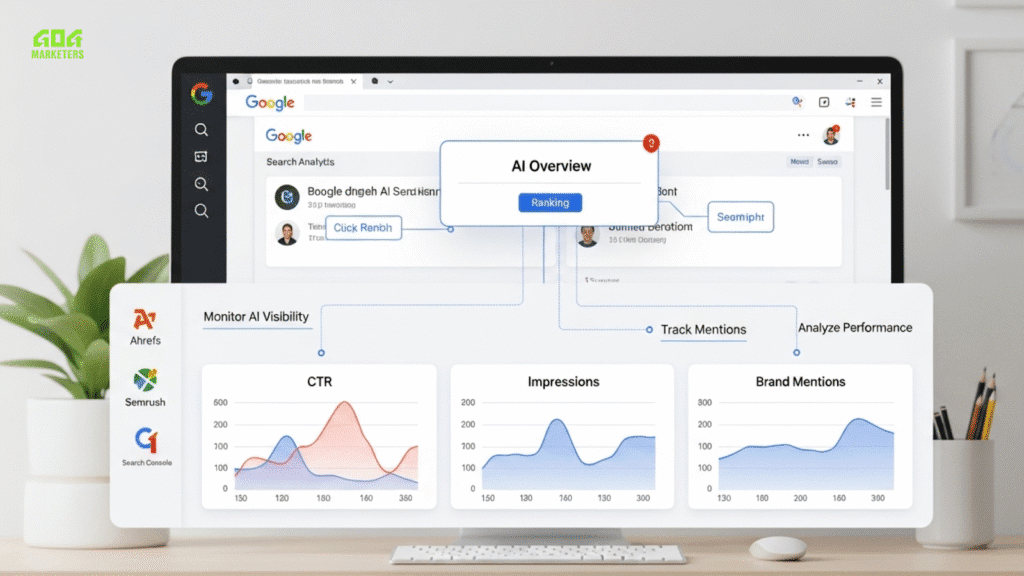How to Get Into Google AI: Overview of the Secret Strategy
Unlock secrets to get into Google AI Overviews! Learn how to get into Google AI using powerful SEO tactics, AI overview ranking tips & proven strategies.
What Is Google AI Overview and Why It’s Changing SEO Forever
In the age of generative AI, Google is evolving its approach to surfacing knowledge. A Google AI Overview (also called an AI-generated summary in Search Generative Experience, or SGE) is a concise, automatically generated summary that aims to answer a user’s query directly at the top of the search results. It pulls insights from multiple web pages, weaves them into a narrative, and then links to supporting sources.
Why this matters for SEO: Instead of just chasing page-one positions, websites now compete to be quoted inside AI Overviews. Being featured there can drive visibility, trust, and impressions even when users don’t click. In fact, AI Overviews now appear in over 50 % of searches, up dramatically from before.
For Indian publishers and businesses, this shift means optimizing for AI visibility is no longer optional, rapidly becoming essential for sustainable organic reach.

How Google Chooses What to Show in AI Overviews
To understand how to get into Google AI overviews, we must unpack how Google’s AI selects content. Here are the major signals (beyond standard SEO) that Google’s AI seems to use:
→ Authority & Trustworthy Sources
The AI favors content from pages that already have expertise signals, backlinks, domain authority, clear author credentials, expert writing, and cited sources.
→ Relevance via Intent & Entities
It matches user intent, not just keywords. It understands entities (concepts, people, tools) and looks for content that covers the topic holistically and deeply.
→ Structure & Clarity
Google AI often extracts content from well-structured sections (with headings, bullet lists, and short paragraphs). If your content is dense or poorly organized, it’s less likely to be parsed.
→ Freshness & Recency
Updated content is more likely to be trusted by an AI model that aims for accuracy. Old or stale content loses weight.
→ Diverse Supporting Sources
Because AI Overviews aggregate multiple sources, your page has to be one of several high-quality references. It’s rarely a lone citation; it’s part of a curated cluster.
→ Schema & Markup Signals
While Google says there are no “special” requirements, using structured data like FAQ, HowTo, or Article markup helps the AI clarify content structure.
In short, Google’s AI acts like a smart curator: it picks pieces from multiple pages that offer clarity, authority, and context.
The Real Reason Most Websites Don’t Appear in AI Overviews
Most content creators believe ranking high (top 3) is enough. But here’s the harsh truth: many pages in the top 10 never get cited in AI Overviews. Why? Because they lack one or more of the above signals. Common pitfalls:
→ Thin or generic content
If your content merely skims a topic, the AI doesn’t find compelling substance to quote.
→ Poor structure & no segmentation
Without an H2/H3 structure, lists, or clear sections, it’s hard for the AI to identify the relevant extract.
→ Lack of entity coverage
You may mention the keyword, but not cover related aspects (synonyms, subtopics, comparisons), so your content doesn’t map well to the AI’s semantic graph.
→ No updates or outdated data
Stale content loses credibility in the face of newer, updated references.
→ Weak or no expert signals
No author bio, no credentials, no citations. These weaken your EEAT (Expertise, Experience, Authority, Trust).
→ No internal linking and topical clusters
If your page floats alone without being integrated into a broader topic hub, it’s less likely to be considered by the AI model.
In Reddit experiments, SEOs have described a trick: update the page so it mimics what they observe in the AI Overview text, then reindex your page is already in the top 10; sometimes it gets cited. That suggests the AI is “looking for matches” against patterns it expects. But blindly copying is dangerousyour content must still be original, useful, and bona fide.
The Secret Strategy SEOs Aren’t Talking About (Revealed!)
Here’s the lesser-discussed but powerful approach to boost your chance of AI Overview inclusion: build an “AI-Eligible Content Cluster with a Weighted Core Page.”
Two key components:
→ Core Pillar Page with AI-friendly Architecture
Create one deep, authoritative “pillar” article on your main topic (e.g., “how to get into Google AI overviews”) that covers all angles, subtopics, FAQs, comparative tables, and internal sections that mirror the structure you expect the AI to summarize.
→ Supporting Content That Fills Out Entity Context
Around the pillar, publish several narrower articles (e.g., “AI overview ranking tips,” “seo for Google AI overview,” “Optimize content for AI results”) that each focus in depth on subtopics or specific angles. These become supporting pages that interlink to the core.
How this works: when AI executes its “query fan-out” (exploring related subtopics), it sees your cluster as a cohesive topical authority. The AI is more likely to pick your core page as a source because it connects seamlessly with your supporting pages and shows depth.
Additionally, use this trick: after publishing your cluster, simulate what you expect the AI Summary to be (in language and structure) within the core pillarwithout copying others, and ensure your headings or paragraph intros echo that. This gives the AI “hooks” inside your content. Then immediately request indexing via Search Console (or via a sitemap ping). Many SEOs have had success with this approach.
This strategy combines classic content hub architecture with anticipatory AI formatting.
Step-by-Step: How to Optimize Your Content for Google AI Overviews
Here’s a precise roadmap to execute “how to get into Google AI overviews”:
→ Identify Keywords & Intent (Long-tail focus)
Focus on longer, informational queries (3–4+ words) with clear user questions. Studies show AI Overviews are more often triggered by specific, long-tail keywords.
→ Build Core Pillar + Satellite Articles
Use the secret strategy above: one pillar page + supporting cluster pages each targeting a subtopic or variation.
→ Use Clear Headings & Section Labels
Each topic in your content should be organized under meaningful H2 and H3 headings. Start paragraphs with a sentence that clearly states the point (to help AI extract). Use bullet lists, tables, or structured lists where possible.
→ Write with EEAT In Mind
Include a byline or author bio with credentials or relevant experience. Cite your sources. Use real examples (especially India-based ones) and data to build trust. Indian case: You might show how a local SEO agency (e.g., a Delhi-based digital marketing firm) got cited in an AI Overview after adopting your cluster strategy.
→ Use Schema Markup
Add structured data like FAQ Page for FAQs, HowTo schema for step guides, Article schema, and Breadcrumb markup. This gives crawlers and AI models extra context.
→ Map Entities & Semantic Context
Mention related concepts, synonyms, comparisons, tools, and metrics. Your content should present a web of related entity references around the main topic.
→ Frequent Updates & Versioning
Set a schedule (e.g., every 3–6 months) to revisit and refresh your content. After updates, resubmit to Search Console for reindexing.
→ Strong Internal Linking
Connect your supporting cluster articles to the core pillar page. Use anchor text that’s relevant and contextually meaningful. This helps Google see them as part of the same knowledge graph.
→ Monitor & Iterate
Track performance, adjust headings, expand sections that AI favors, and refine over time.
When executed well, this process increases your chance of being one of the URLs pulled into AI Overviews for relevant queries.
Pro Tips: Tools and Techniques to Track Your AI Overview Presence
Since Google Search Console doesn’t explicitly show AI Overview appearances, you’ll need special tools or techniques:
→ Use rank tracking tools that detect AI Overviews
Keyword.com, Ahrefs, Semrush, Advanced Web Ranking, SE Ranking, and Ziptie all offer AI Overview or SERP feature tracking capabilities.
→ Use Advanced Web Ranking’s “Google AI Overview” feature
You can run detailed SERP analyses and monitor which of your pages are cited in AI Overviews.
→ Monitor CTR vs Impressions in Search Console
If you’re holding high ranks but see declining CTRs, that could indicate AI Overviews are stealing clicks. Use this as a directional signal.
→ Use “share of AI voice” tools
Some emergent tools or community experiments, like FalconRank, track how much your brand appears in generative AI vs competitors.
→ Manual sampling
Do test searches for queries you target, see if an AI Overview appears, and whether one of your pages is cited. This gives you concrete qualitative insight.
By combining these tracking methods, you’ll know when your content is earning AI citations and where to double down.

The Future of SEO: How AI Overviews Will Shape Search in 2025 and Beyond
As Google expands its AI capabilities (e.g., AI Mode, multimodal reasoning), AI Overviews will become more dynamic, contextually rich, and interactive.
Here’s what to expect and how to prepare:
→ Greater “zero-click” dominance
More searchers will get answers directly on SERPs without needing to click. The value will shift more to mentions and brand presence than pure traffic.
→ Multistep reasoning & follow-ups
Google may generate overviews that include questions or ask for clarifications. Your content might need to preempt follow-up queries.
→ More visual & multimodal pulls
AI may extract images, videos, charts, or audio. Content with rich media alt text and structured captions could be selected more often.
→ Competitive clustering
Brands that create tight topic clusters and cover content deeply will outpace those relying on individual articles.
→ Authority consolidation
Sites with strong domain trust, subject matter depth, and consistent updates will be more likely to dominate generative AI citations.
Thus, the future of SEO is not just about ranking; it’s about being part of the answer narrative.
Final Thoughts: Mastering the Art of Getting Into Google AI Overviews
To wrap up, here are your actionable takeaways:
→ Build a powerful cluster strategy (pillar + supporting pages) tailored to AI summary structure
→ Use clear headings, structured content, entity context, and schema markup
→ Show EEAT through bios, citations, data, and real examples
→ Update regularly and request reindexing
→ Track your AI visibility via specialized tools
→ Iterate, test, and optimize further
In India’s digital landscape, where competition in SEO is fierce, being cited in Google AI Overviews adds a new frontier of visibility. Start with one topic cluster, apply the strategy above, and monitor whether your pages begin appearing in AI Overviews for your target queries.
The margin between “good content” and “AI-eligible content” is narrowing, and those who adapt early will reap the rewards.
FAQs
1. What are the AI Overview ranking tips for beginners?
→ Focus on long-tail informational queries → structure your content with clear headings and lists → use schema markup → build a topic cluster for authority → refresh content regularly.
2. How to rank in AI search instead of just organic SEO?
→ Think beyond keywords: optimize for intent, entities, and structure → use supporting content to build depth → anticipate what the AI might quote and make your headings match that style.
3. Is “seo for Google AI overview” different from regular SEO?
→ Yesin addition to standard SEO, you must structure content for extraction, build authority networks, and anticipate generative models’ preferred formats.
4. Can any page get cited in an AI Overview?
→ Technically yes, if it’s indexed and meets Google’s policy. But only pages with authority, clarity, and relevant context are likely to be selected.
5. How often should I monitor whether my content appears in AI Overviews?
→ Check weekly initially using rank trackers; once stable, switch to monthly monitoring and quarterly content audits.
6. Does being in an AI Overview reduce my clicks?
→ Sometimes, yes. But being cited still gives brand visibility. Your goal is to turn those impressions into trust, repeat traffic, and indirect conversions.
7. Will AI Overviews replace organic results fully?
→ Not fully, at least not immediately. But over time, AI summaries may dominate many informational queries. That’s why adapting now is crucial.
Now that you know how to rank in Google AI Overviews, the next step is to optimize your website content.
👉 Read this next: 5 Performance Marketing Services Roadmap: Proven Strategy to Boost Your ROI Fast in 2025

Partiksha is a dedicated and industrious Content Writer at 404 Marketers, a leading digital marketing agency in Delhi. Has completed her Graduation in B.Com from the University of Delhi. She stands out as a skilled and passionate content writer dedicated to delivering measurable results for clients. With 5 years of experience and expertise in Keyword research, unique & SEO optimized content. Her strong background in content writing, social media management, and content creation enables her to design strategies that align perfectly with business goals.
Through her expertise, she helps brands at 404 Marketers achieve sustainable growth and lasting digital success.

